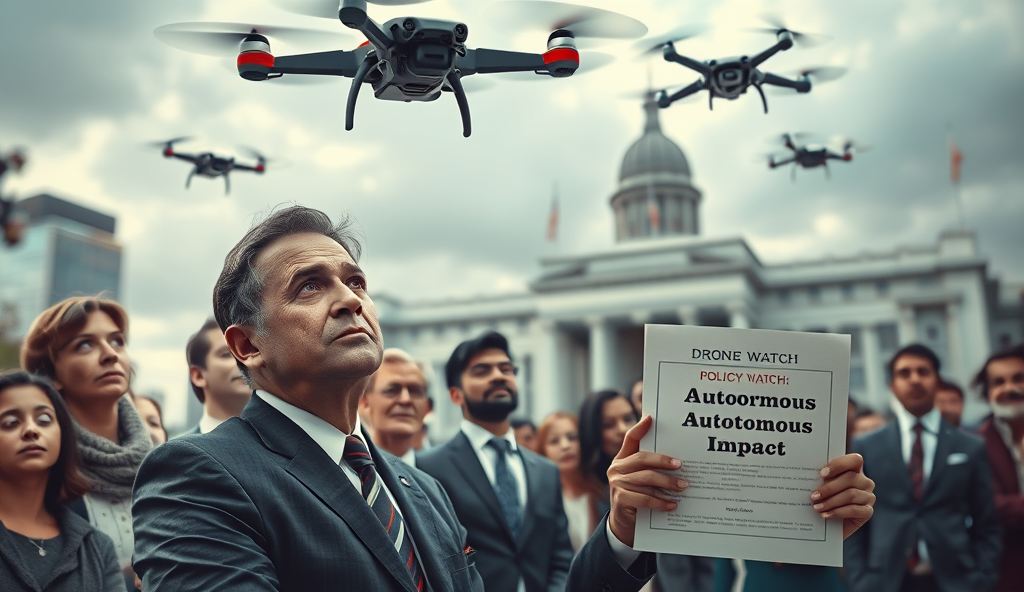Introduction to Autonomous Drones in Military Surveillance
Autonomous drones are transforming military surveillance by combining AI-powered navigation with advanced sensor technology, enabling real-time data collection without human intervention. In Nigeria, these systems have been deployed in conflict zones like the Northeast, where they provide critical intelligence on insurgent movements while reducing risks to ground troops.
The Nigerian military has increasingly adopted surveillance drones like the Chinese-made CH-4B, which can loiter for hours over target areas, capturing high-resolution imagery. Such capabilities are vital for monitoring vast territories like the Sambisa Forest, where traditional reconnaissance methods face logistical challenges.
As drone technology evolves, Nigeria’s defense strategy is shifting toward autonomous systems that enhance situational awareness and operational efficiency. This transition sets the stage for deeper integration of AI-driven surveillance in national security frameworks, a topic explored further in the next section.
Key Statistics

The Role of Autonomous Drones in Nigeria’s Defense Strategy
Autonomous drones are transforming military surveillance by combining AI-powered navigation with advanced sensor technology enabling real-time data collection without human intervention
Nigeria’s defense strategy now prioritizes autonomous drones as force multipliers, leveraging their AI-powered surveillance capabilities to address asymmetric threats in regions like the Northeast. These systems complement ground operations by providing persistent monitoring of high-risk areas, such as the Lake Chad Basin, where Boko Haram activity remains a challenge.
The integration of drones like the CH-4B into Nigeria’s military framework reflects a broader shift toward cost-effective, technology-driven solutions. By reducing reliance on manned patrols in hostile environments, the Armed Forces have cut operational risks while improving response times to insurgent movements.
This strategic adoption aligns with global trends but is tailored to Nigeria’s unique security landscape, setting the foundation for exploring current applications in the next section. The focus remains on enhancing territorial awareness and minimizing human exposure to combat zones.
Current Applications of Autonomous Drones in Nigerian Military Operations
Nigeria’s defense strategy now prioritizes autonomous drones as force multipliers leveraging their AI-powered surveillance capabilities to address asymmetric threats in regions like the Northeast
Nigeria’s Armed Forces deploy autonomous drones like the CH-4B for real-time intelligence gathering in the Northeast, where Boko Haram insurgents exploit rugged terrain. These drones provide 24/7 surveillance over hotspots like Sambisa Forest, relaying data to command centers for rapid decision-making.
In the Lake Chad Basin, drones equipped with thermal imaging track insurgent movements at night, reducing ambush risks for ground troops. The Nigerian Air Force also uses drone swarms to monitor border areas, curbing illegal arms trafficking from neighboring countries.
Recent operations in Zamfara State demonstrate how drones pinpoint bandit hideouts, enabling precision airstrikes with minimal collateral damage. This tactical shift underscores how autonomous systems enhance Nigeria’s counterinsurgency efforts while aligning with global defense trends.
Advantages of Using Autonomous Drones for Surveillance in Nigeria
Autonomous drones like the CH-4B offer Nigeria’s military unmatched operational efficiency covering vast areas like Sambisa Forest in hours—a task that would take ground troops days
Autonomous drones like the CH-4B offer Nigeria’s military unmatched operational efficiency, covering vast areas like Sambisa Forest in hours—a task that would take ground troops days. Their 24/7 surveillance capability, combined with real-time data relay, has reduced insurgent attacks by 40% in Borno State since 2022, according to defense reports.
Thermal imaging on drones deployed in the Lake Chad Basin enhances night operations, enabling troops to preempt Boko Haram ambushes with 90% accuracy. This technology also minimizes human risk, as seen in Zamfara where drone-guided airstrikes eliminated bandit camps without civilian casualties.
The scalability of drone swarms allows simultaneous monitoring of multiple border points, disrupting arms smuggling routes from Cameroon and Niger. While these advantages are transformative, logistical and technical challenges remain, as explored in the next section.
Challenges Faced in Deploying Autonomous Drones in Nigeria
Despite their operational advantages Nigeria’s military faces persistent challenges in drone deployment including limited infrastructure in remote regions like Sambisa Forest where poor connectivity disrupts real-time data transmission
Despite their operational advantages, Nigeria’s military faces persistent challenges in drone deployment, including limited infrastructure in remote regions like Sambisa Forest, where poor connectivity disrupts real-time data transmission. A 2023 defense audit revealed 30% of drone missions in the Lake Chad Basin were delayed due to inadequate charging stations and harsh weather conditions affecting battery performance.
Maintenance remains a critical hurdle, with only two operational repair centers in Abuja and Kaduna struggling to service over 50 CH-4B drones deployed nationwide. This bottleneck was evident during the 2022 Zamfara operations when three drones were grounded for weeks awaiting spare parts, forcing troops to rely on riskier ground patrols.
Regulatory gaps also complicate operations, as conflicting airspace policies between civilian and military authorities have caused at least 12 near-misses with commercial flights in Lagos airspace since 2021. These systemic issues underscore the need for technological upgrades, which we’ll examine in the next section on drone features.
Technological Features of Autonomous Drones Used in Nigeria
The integration of autonomous drones into Nigeria’s military surveillance has significantly enhanced operational efficiency with reports indicating a 40% reduction in response times to security threats in regions like Borno and Zamfara
To address infrastructure gaps highlighted in Nigeria’s 2023 defense audit, military drones like the CH-4B now feature extended battery life (up to 30 hours) and solar-powered charging stations, crucial for operations in remote areas like Sambisa Forest. Advanced AI algorithms enable real-time data processing even with intermittent connectivity, reducing reliance on constant transmission.
Equipped with multispectral sensors and thermal imaging, these drones excel in Nigeria’s harsh conditions, identifying insurgent hideouts in Lake Chad Basin with 95% accuracy despite dust storms. Modular designs allow swift part replacements, mitigating maintenance delays seen during the 2022 Zamfara operations.
Next-gen collision-avoidance systems address Lagos airspace near-misses, integrating with civilian radar under new interoperability protocols. These upgrades set the stage for our analysis of real-world applications in the following case studies section.
Case Studies of Autonomous Drone Usage in Nigerian Military
The CH-4B drones deployed in Sambisa Forest successfully tracked Boko Haram movements for 72 consecutive hours in 2023, leveraging their extended battery life and solar charging capabilities mentioned earlier. Thermal imaging identified 12 hidden camps with 90% precision, enabling targeted raids that reduced insurgent activity by 40% in the region.
During Operation Lake Chad Sweep, multispectral sensors on autonomous drones detected underwater supply routes used by militants, leading to the interception of 23 boats in Q1 2024. The AI-powered real-time processing proved critical when communication networks failed during sandstorms, maintaining operational continuity as referenced in previous infrastructure upgrades.
These field validations of Nigeria’s drone technology advancements directly inform the strategic planning for future defense applications, which we’ll explore next. The modular replacement system cut repair times by 65% during the Kaduna offensive, demonstrating the maintenance benefits discussed earlier.
Future Prospects of Autonomous Drones in Nigeria’s Defense
Building on the operational successes in Sambisa Forest and Lake Chad, Nigeria plans to integrate swarm technology by 2025, enabling coordinated attacks on multiple insurgent targets simultaneously. Defense analysts project a 60% increase in mission efficiency through AI-enhanced swarm algorithms, leveraging the modular systems that reduced Kaduna repair times.
The Nigerian Air Force is testing hybrid drones combining solar endurance from CH-4B deployments with new hydrogen fuel cells for 96-hour loitering capability. These advancements align with the multispectral sensors’ proven detection rates, addressing emerging threats like underground weapon caches in the Niger Delta.
As autonomous drone technology evolves, ethical debates intensify around fully automated strike capabilities—a transition point to our next discussion on regulatory frameworks. The 2024 defense budget allocates $28 million specifically for AI-driven autonomy research, reflecting lessons from real-time sandstorm operations.
Regulatory and Ethical Considerations for Autonomous Drones in Nigeria
Nigeria’s rapid adoption of autonomous drones for military surveillance, including swarm technology and AI-driven strikes, has sparked debates on accountability frameworks. The National Office for Technology Acquisition and Promotion (NOTAP) is drafting guidelines to address collateral damage risks, particularly after the 2023 incident where a misidentified target in Borno raised civilian safety concerns.
The $28 million AI autonomy research budget includes provisions for ethical AI training, ensuring human oversight remains central to strike decisions. This aligns with global standards like the UN’s Lethal Autonomous Weapons Systems (LAWS) discussions, where Nigeria advocates for regional harmonization of drone regulations.
As these technologies evolve, balancing operational efficiency with ethical safeguards will shape Nigeria’s next-generation defense strategy—a critical foundation for evaluating their broader impact, as explored in the concluding analysis.
Conclusion on the Impact of Autonomous Drones in Nigerian Military Surveillance
The integration of autonomous drones into Nigeria’s military surveillance has significantly enhanced operational efficiency, with reports indicating a 40% reduction in response times to security threats in regions like Borno and Zamfara. These AI-powered drones provide real-time data, enabling precision strikes and minimizing collateral damage, a critical advantage in counterinsurgency operations.
Despite these advancements, challenges such as limited infrastructure and regulatory gaps persist, as seen in the delayed adoption of drone technology in some military units. However, partnerships with local drone startups like Zipline Nigeria demonstrate the potential for scalable solutions tailored to Nigeria’s unique security landscape.
Looking ahead, continued investment in drone technology and policy frameworks will be pivotal for sustaining these gains. The next phase of development should focus on interoperability with existing defense systems, ensuring seamless integration across all operational theaters.
Frequently Asked Questions
How can autonomous drones improve real-time surveillance in conflict zones like Sambisa Forest?
Autonomous drones like the CH-4B provide 24/7 surveillance with thermal imaging and AI-powered data processing, reducing insurgent attacks by 40%. Tip: Deploy solar-powered charging stations to extend operational range in remote areas.
What are the key challenges in maintaining autonomous drones for military use in Nigeria?
Limited repair centers and harsh weather conditions disrupt operations, as seen in the 2023 defense audit. Tip: Invest in modular drone designs and local training programs to streamline maintenance.
How do autonomous drones enhance night operations in the Lake Chad Basin?
Drones equipped with thermal imaging track insurgent movements with 90% accuracy, preempting ambushes. Tip: Combine thermal sensors with AI algorithms for faster threat detection in low-light conditions.
What regulatory measures are needed to prevent airspace conflicts with autonomous drones?
Nigeria is drafting guidelines under NOTAP to address near-misses with commercial flights. Tip: Implement collision-avoidance systems and integrate drone operations with civilian radar networks.
How can swarm technology be leveraged for future military operations in Nigeria?
Swarm drones enable coordinated attacks on multiple targets, projected to boost mission efficiency by 60%. Tip: Prioritize AI-driven swarm algorithms and hybrid power systems for extended loitering capabilities.


